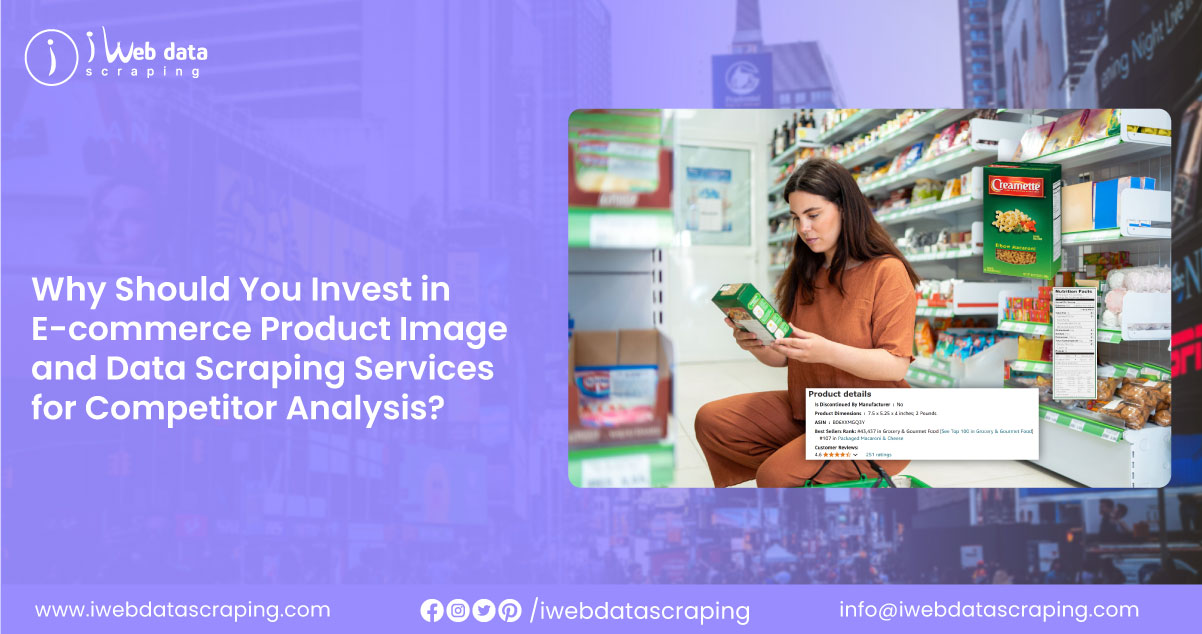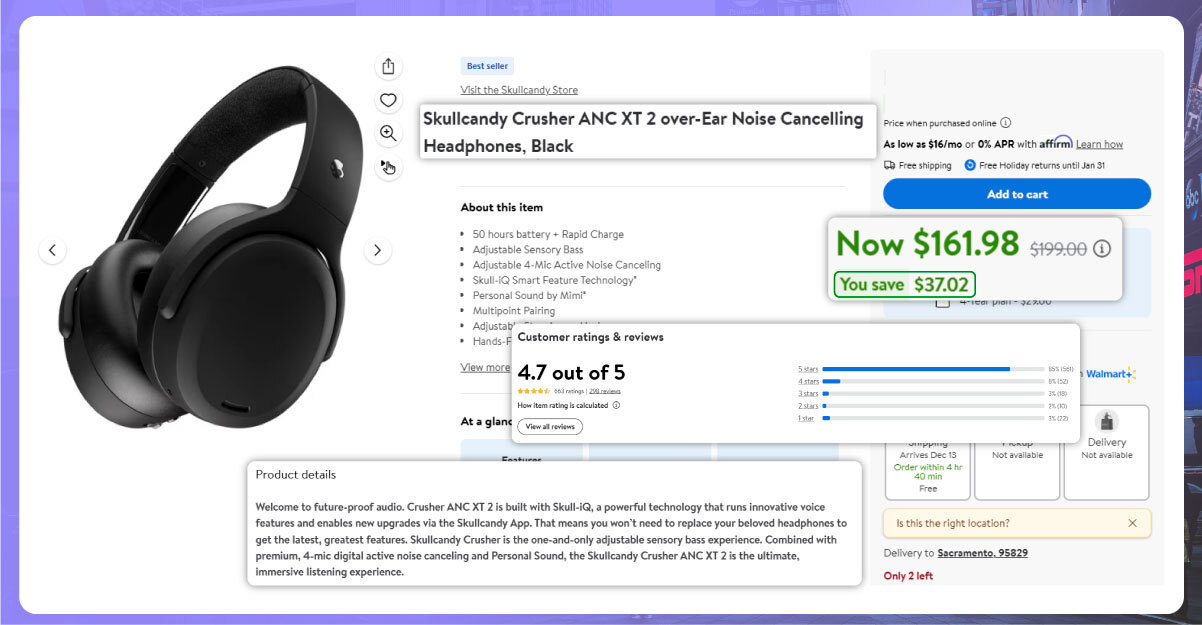

In the fast-paced world of e-commerce, data has become one of the most valuable assets for businesses striving to remain competitive. The digital marketplace continuously evolves, with vast product information and images scattered across numerous websites. For online retailers, accessing and analyzing this data is crucial for improving product offerings, optimizing marketing strategies, and enhancing customer experiences. Web scraping is one of the most effective methods for obtaining this valuable information.
Web scraping, or web harvesting, is extracting data from websites using specialized software or scripts. By scraping e-commerce product images and data, businesses can gain real-time insights into market trends, pricing, and inventory levels. E-commerce Product Image and Data Scraping Services allow businesses to collect accurate and up-to-date product details from online stores. With the ability to scrape e-commerce product details and photos, retailers can enhance their product catalogs and marketing efforts.
This article will delve into the importance of web scraping for e-commerce, its applications, challenges, and the benefits it provides to online retailers. Ecommerce Product Data Scraping empowers businesses to remain agile and responsive in a highly competitive market, offering a strategic advantage in understanding consumer preferences, competitor pricing, and emerging trends.
In today's e-commerce landscape, data drives decision-making. Product images and data are the core of an online retailer's success. Consumers rely heavily on product descriptions and visual representations before purchasing. Clear, high-quality images and detailed product information are essential for providing a positive online shopping experience. These elements directly impact customer trust, purchase intent, and conversion rates.
However, manually collecting accurate, up-to-date data from competitors or marketplaces can take time and effort. This is where web scraping comes in. Businesses can extract vast amounts of product images and data with minimal effort by automating the data collection process. An Online Product Data & Image Scraping Tool allows businesses to efficiently gather the necessary data, streamlining the process and freeing up valuable time for other tasks. This automation saves time and ensures businesses can keep their product listings fresh and competitive.
1. Market Research and Competitive Analysis

One primary use of web scraping is to gather insights on competitors. Online retailers can track competitor pricing, product descriptions, and inventory levels across various e-commerce platforms. For example, by scraping e-commerce websites such as Amazon, eBay, or Walmart, businesses can compare the prices of similar products, monitor competitor promotions, and adjust their pricing strategies accordingly.
Product images also play a critical role in market research. By scraping competitors' visual content, businesses can see how competitors present their products and gain insights into the type of images that attract customers. This can help retailers refine their product photography, making their listings more appealing and aligned with market trends. Extract High-Quality Product Images & Data to enhance their product visuals to meet consumer expectations.
Additionally, leveraging E-Commerce Data Extraction Services allows businesses to automate the extraction of images and product data, significantly improving their ability to respond to market dynamics.
2. Product Comparison and Catalog Optimization

Product comparison is a common feature online shoppers look for on e-commerce websites. Scraping product data from different platforms allows businesses to create a detailed catalog that compares similar items. This can involve comparing product features, prices, reviews, ratings, and images.
E-commerce businesses can also use scraped data to optimize their catalogs. By analyzing the attributes of popular products, retailers can identify gaps in their offerings and adjust their inventory accordingly. Additionally, scraping product images can help businesses ensure that they are using the best possible images to showcase their products in a competitive market. With the help of a Retail Website Image & Product Data Scraper, businesses can easily collect and manage this valuable data, enabling them to refine their product catalogs and improve their online presence.
3. Price Monitoring and Dynamic Pricing

Price is a critical factor in consumer purchasing decisions. By scraping e-commerce websites for pricing information, businesses can track price fluctuations for similar products, monitor promotional discounts, and detect price changes in real time. This information enables retailers to implement dynamic pricing strategies that adjust product prices based on market trends, competitor pricing, or demand.
For example, if a business notices that a competitor is offering a significant discount on a popular product, it can adjust their pricing to stay competitive. Similarly, if demand for a particular product increases, businesses can use scraped data to raise prices accordingly and maximize profits. Utilizing Online Retail Image and Product Data Collection allows businesses to access valuable pricing data, which is key to staying ahead in the competitive e-commerce market.
4. Improving Customer Experience

The quality of product images and descriptions is essential in shaping the customer's online shopping experience. By scraping high-quality product images and detailed descriptions, businesses can ensure that their product listings are as attractive and informative as possible. Clear, consistent, and visually appealing images have been shown to boost customer trust, enhance the likelihood of a purchase, and reduce returns.
Scraping product reviews and ratings enhances product listings and improves customer experience. Retailers can analyze customer feedback, identify common issues or concerns, and use that data to improve the quality of their own products or services. Using an E-Commerce Data Scraper to gather this information allows businesses to stay ahead by keeping their listings up-to-date and customer-focused.
5. Enhancing Marketing Strategies

Product data and images from web scraping can also be utilized for targeted marketing campaigns. By analyzing competitor product offerings, retailers can identify popular products and trends that can be promoted through online ads, social media campaigns, or email marketing. Moreover, scraped images and product descriptions can create attractive promotional content that resonates with consumers.
For example, a business may notice a surge in the popularity of a specific type of accessory or gadget through web scraping. This insight can be leveraged to develop a targeted marketing campaign featuring these trending products, boosting visibility and sales. By utilizing E- Commerce Product Datasets, businesses can optimize their marketing efforts to reach the right audience with the right products at the right time.
6. Inventory Management and Stock Monitoring

Managing inventory effectively is one of the most critical tasks for an e-commerce business. By scraping product availability data from various online stores, retailers can monitor the stock levels of their competitors and anticipate potential shortages or overstocking of specific items. This real-time data helps businesses maintain optimal stock levels, ensuring they meet customer demand without over-investing in inventory.
Additionally, web scraping allows businesses to monitor the availability of limited-edition or seasonal products. This ensures that businesses are well-stocked with the products that are most likely to generate high sales, particularly during peak shopping seasons like Black Friday, Cyber Monday, and Christmas.
7. Legal and Ethical Considerations in Web Scraping

While web scraping offers significant advantages, businesses must know the legal and ethical issues surrounding this practice. Many e-commerce websites have terms of service that restrict scraping, and violating these terms could result in legal consequences or being banned from accessing the site.
To ensure compliance, businesses should consider implementing responsible scraping practices. This involves scraping data that does not overload the target website's servers or disrupt normal operations. Additionally, businesses should avoid scraping sensitive data, such as personal information or proprietary content, unless they have explicit permission.
Another consideration is ensuring that the use of scraped data is consistent with copyright laws. Intellectual property laws may protect product images, descriptions, and other content on e- commerce websites. Therefore, businesses must be cautious about using scraped images and product data to avoid infringing these rights.
Scraping e-commerce product data and images offers businesses valuable insights into market trends, competitor strategies, and customer preferences. By automating data collection, retailers can optimize product listings, pricing, inventory, and marketing efforts, leading to enhanced customer experiences and increased sales.
1. Efficiency and Cost-Effectiveness
Web scraping automates data collection, making it faster and more cost-effective than manual research. By scraping e-commerce websites, businesses can gather vast amounts of product data in real time, allowing them to stay competitive without dedicating substantial resources to data collection.
2. Real-Time Insights
E-commerce is a fast-moving industry, and staying current with market trends, product prices, and inventory levels is critical. Web scraping provides businesses with real-time data, enabling them to react quickly to changes in the marketplace and adjust their strategies accordingly.
3. Data-Driven Decisions
By gathering data from multiple sources, businesses can make more informed decisions based on actual market conditions rather than relying on guesswork or outdated information. Scraped data provides valuable insights into consumer preferences, competitor activity, and market trends.
4. Scalability
Web scraping allows businesses to scale their data collection efforts without increasing their workload. Whether a business wants to track a handful of competitors or monitor thousands of products across multiple platforms, scraping tools can easily handle large-scale data extraction.
Web scraping e-commerce product images and data has revolutionized how online retailers gather and use information to improve their business strategies. From market research and competitive analysis to pricing optimization and marketing, the insights from scraped data are critical in driving business success. By scraping product data from leading e-commerce websites, businesses can stay ahead of trends, optimize inventory, and enhance the customer experience. However, businesses need to conduct scraping responsibly, legally, and ethically to avoid potential issues and ensure long-term success.
Experience top-notch web scraping service and mobile app scraping solutions with iWeb Data Scraping. Our skilled team excels in extracting various data sets, including retail store locations and beyond. Connect with us today to learn how our customized services can address your unique project needs, delivering the highest efficiency and dependability for all your data requirements.